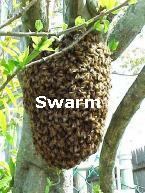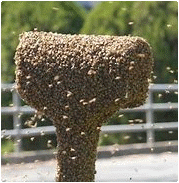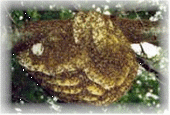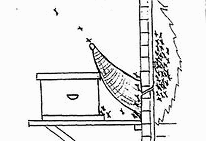
|
Why and How Honey bees swarm What is a swarm?
Nature has programmed the honey bee to swarm as a method of
propagating the species. This
can occur during most any When a swarm occurs, approximately 60% of the bees in the colony will leave their hive in a swirling mass and settle in a large cluster on some nearby object such as a tree limb. They will stay clustered from a few minutes to several days depending on weather and other things. When they break the swarm cluster, they will leave in a swirling mass just as they came and move to a permanent home. If they are going
to leave, why bother them? Where they go when they leave should be the homeowner’s main concern. honey bees will take up housekeeping in any cavity that is large enough for their colony. If there are openings in the exterior of a house or other structure, they might well move in! The space afforded by wall studs, floor joist and attic spaces are ideal. To prevent this happening, the homeowner is welcomed to contact the beekeeper nearest you and they will come and remove the hanging swarm usually at no charge to the homeowner. Some beekeepers do however charge for hanging swarm removal. Whether or not there is a charge and how much should always be clearly understood before committing to remove a swarm or have one removed. As soon as you spot a swarm in your area, look all around your home and other structures for 200 or so bees congregating in any one location on any surface of the structure. Thais is a sign that the bees are seriously considering that location for a new home. If you see this, blocking the bee’s entry will prevent the bees from entering BUT that does subject the homeowner to possible stings. The best course of action is to contact a beekeeper quickly. Before the homeowner calls the beekeeper they should be prepared to furnish the following information:
The beekeeper should give you his cell phone number so that you can keep an eye on the cluster and let him know if it leaves. This can save him an expensive trip to your place should they leave. It is pretty common practice for the beekeeper to leave the hived swarm on your property until after dark the day it is collected. Most if not all of the bees will go inside the hive at dark and the beekeeper will take all of them away. If the hived swarm is removed as soon as it is hived, there will likely be several hundred bees lost and will hang around the area for a day or so looking for the swarm. If this happens, the lost bees will return to the hive they originally came from within a few days unless the queen (or a queen) was left behind. If that happens the remaining bees will cluster again somewhere with the “left behind” queen. These clusters are generally small.
What is a swarm andwhy
do honey bees
swarm? As stated above swarming is nature’s way of prorogating the
honey bee species. Honey bees
start raising young bees in late winter in anticipation of the spring blooms.
A queen bee can lay up to 2,000 eggs a day during
When the bees decide to issue a swarm, they start swarm prep by reducing the queen’s diet so that she will stop laying so prolifically and will slim down to a flying weight. The worker bees start several new queen cells. Before the new queen emerge from their cells, roughly 60% of the bees in the colony will leave with the old queen and that is a swarm. After the swarm has left, the new queens start emerging from their cells. The first one to emerge will normally kill the remaining queens and she will become the matriarch of the colony. Since the swarm is looking for a new home, the beekeepers beehive is a luxury apartment to the swarm and they will set up housekeeping quiet quickly and start preparing for the soon to come winter.
Occasionally a swarm will stay where they originally settle and make that their new home. When this happens it is no longer a swarm but is now a colony. Colonies will defend their nest. When you see a hanging mass of honey bees, look for signs of honeycomb. If you see any comb, that is most likely a colony and they can be very aggressive if agitated. What happens if the
bees succeed in moving in to a building? Once the bees move into a structure and take up residence, the average beekeeper will not remove them mainly due to the time commitment and liability problems. Some beekeepers do specialize in removing bees from structures (click here for a Huntsville, AL area listing). There is usually a charge for this service. There are two common ways to remove a live colony from a structure.
There is usually a charge for trap out service. Honey bees have a relatively new pest in Why not just poison
the bees in the wall? If you poison them you will have a wall full of dead bees and brood and possibly a lot of honey and pollen left behind. If you do not “stop up” the hive opening, another colony is likely to move in. Dead bees and brood have a very offensive odor as they decay. Pollen and honey attract ants, roaches, rodents and other undesirable pests. The bees in a live functioning colony keep the colony temperature regulated at around 94°F. Once the bees are gone, so is the temperature control and as the weather gets hotter, the comb usually gets softer to the point that it will no longer support the weight of the honey stored within. When this happens, the honey can drip through the ceiling or wall into the structure until all of the supply of stored honey is depleted. Why not just leave
them alone and let them stay in the structure? This is not at all a bad option. If the ingress egress point is above “head high” to pedestrian, the bee’s flight will remain above pedestrians and are likely to never cause a problem. Bees fly in a “bee line” from hive to nectar source. That means they will go pretty much straight from the hive entrance to the nectar source. The best nectar sources are trees, not plants so the bees may never encounter people until you need your house painted. A painter with a simple bee veil, gloves and long sleeve shirt can paint right up to the hive entrance and is likely to never have a problem. END FO FILE 4/14/09 bra last update 5/18/2020 |
 summer month but is primarily limited to the months of March, April and May.
summer month but is primarily limited to the months of March, April and May. peak
brood production, which is several times her body weight.
peak
brood production, which is several times her body weight.
 leaving the hive for the first time, will orient them selves to the hive
entrance.
leaving the hive for the first time, will orient them selves to the hive
entrance.